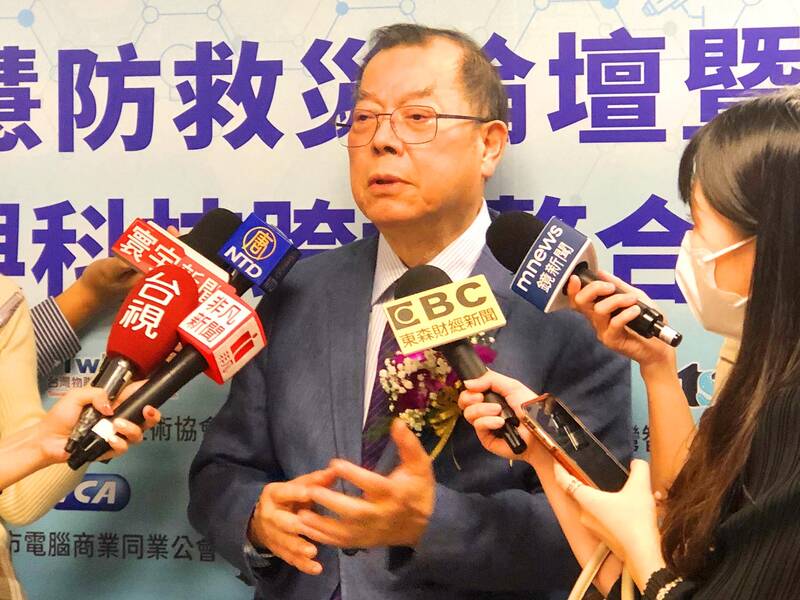The competitive advantage of Taiwan’s semiconductor industry is based on conditions created locally and the key to the industry’s development hinges on how to maintain its competitiveness rather than reducing reliance on the country by moving operations overseas, Powerchip Semiconductor Manufacturing Corp (力積電) chairman Frank Huang (黃崇仁) said on Wednesday.
Taiwan’s global dominance of semiconductor fabrication is built mainly on the back of high-caliber engineers, relatively low costs and the high cost-performance ratio of domestic industry, Huang said.
These factors enable chipmakers to push prices lower than their counterparts in the US and other countries, he said.

Photo: CNA
In such a situation, Taiwan Semiconductor Manufacturing Co (TSMC, 台積電) is highly profitable and can continue to invest heavily in advanced processes, thereby remaining the industry leader, he said.
Many conditions have allowed Taiwan’s semiconductor industry to maintain its edge, including professional engineers, the internationalization of the industry and government support for the building of new fabs, Huang said.
Without these conditions, that advantage does not exist, even if semiconductor manufacturing companies move their operations overseas or build new plants in the US, he said.
Huang’s comments came as the international community has begun to discuss the need for the semiconductor industry to reduce its reliance on Taiwan to minimize risks to the global economy amid geopolitical tensions and a major chip shortage.
Referencing this discussion of “de-Taiwanization” in the semiconductor industry, Huang said that the key to the sector’s future development is how to maintain its competitiveness, for instance, by continuing to cultivate top engineers through semiconductor technology and research institutions.
The government needs to keep providing resources including land, energy, water and tax incentives to support the industry’s development, he said.
The US semiconductor industry is the global leader in IC design and semiconductor manufacturing equipment, while Taiwan holds a leading position in the wafer manufacturing process, Huang said, adding that Taiwan’s competitive advantage cannot be easily replicated.
Successful semiconductor investment is not just about money, Huang said, adding that TSMC has 30 years of experience in industry development.
On Tuesday, TSMC announced that it would hold the first tool-in ceremony for its fab in Arizona next month to install the first batch of production equipment at the plant.
Taiwan has built its strength in the field and would be able to export its semiconductor technology, Huang said.
Regarding US efforts to jointly develop the industry with Japan, Huang said they still need Taiwan, citing the example of a joint venture between Japan’s Sony Group Corp, Denso Corp and TSMC to build a fab in Kumamoto.
National Development Council Minister Kung Ming-hsin (龔明鑫) earlier this week told a legislative session that removing Taiwan from the semiconductor supply chain would not be easy given the country’s strength in advanced semiconductor technology research and development.
The most important thing Taiwan can do is to continue working to strengthen its semiconductor supply chain resilience, Kung said.

‘SHORT TERM’: The local currency would likely remain strong in the near term, driven by anticipated US trade pressure, capital inflows and expectations of a US Fed rate cut The US dollar is expected to fall below NT$30 in the near term, as traders anticipate increased pressure from Washington for Taiwan to allow the New Taiwan dollar to appreciate, Cathay United Bank (國泰世華銀行) chief economist Lin Chi-chao (林啟超) said. Following a sharp drop in the greenback against the NT dollar on Friday, Lin told the Central News Agency that the local currency is likely to remain strong in the short term, driven in part by market psychology surrounding anticipated US policy pressure. On Friday, the US dollar fell NT$0.953, or 3.07 percent, closing at NT$31.064 — its lowest level since Jan.

The US dollar was trading at NT$29.7 at 10am today on the Taipei Foreign Exchange, as the New Taiwan dollar gained NT$1.364 from the previous close last week. The NT dollar continued to rise today, after surging 3.07 percent on Friday. After opening at NT$30.91, the NT dollar gained more than NT$1 in just 15 minutes, briefly passing the NT$30 mark. Before the US Department of the Treasury's semi-annual currency report came out, expectations that the NT dollar would keep rising were already building. The NT dollar on Friday closed at NT$31.064, up by NT$0.953 — a 3.07 percent single-day gain. Today,

The New Taiwan dollar and Taiwanese stocks surged on signs that trade tensions between the world’s top two economies might start easing and as US tech earnings boosted the outlook of the nation’s semiconductor exports. The NT dollar strengthened as much as 3.8 percent versus the US dollar to 30.815, the biggest intraday gain since January 2011, closing at NT$31.064. The benchmark TAIEX jumped 2.73 percent to outperform the region’s equity gauges. Outlook for global trade improved after China said it is assessing possible trade talks with the US, providing a boost for the nation’s currency and shares. As the NT dollar

PRESSURE EXPECTED: The appreciation of the NT dollar reflected expectations that Washington would press Taiwan to boost its currency against the US dollar, dealers said Taiwan’s export-oriented semiconductor and auto part manufacturers are expecting their margins to be affected by large foreign exchange losses as the New Taiwan dollar continued to appreciate sharply against the US dollar yesterday. Among major semiconductor manufacturers, ASE Technology Holding Co (日月光), the world’s largest integrated circuit (IC) packaging and testing services provider, said that whenever the NT dollar rises NT$1 against the greenback, its gross margin is cut by about 1.5 percent. The NT dollar traded as strong as NT$29.59 per US dollar before trimming gains to close NT$0.919, or 2.96 percent, higher at NT$30.145 yesterday in Taipei trading